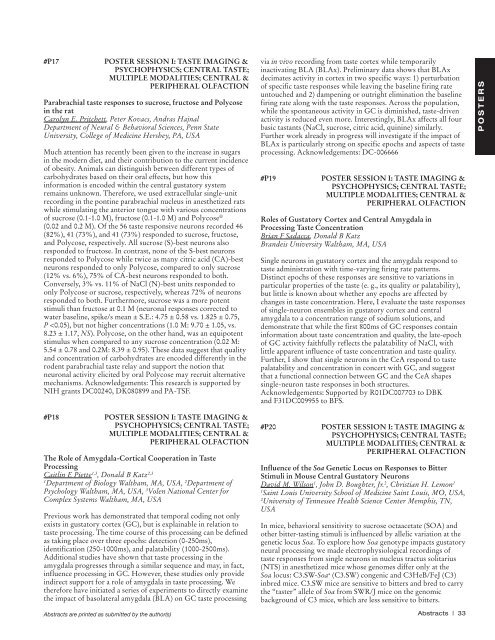Abstracts - Association for Chemoreception Sciences
Abstracts - Association for Chemoreception Sciences
Abstracts - Association for Chemoreception Sciences
You also want an ePaper? Increase the reach of your titles
YUMPU automatically turns print PDFs into web optimized ePapers that Google loves.
#P17 POSTER SESSION I: TASTE IMAGING &<br />
PSYCHOPHYSICS; CENTRAL TASTE;<br />
MULTIPLE MODALITIES; CENTRAL &<br />
PERIPHERAL OLFACTION<br />
Parabrachial taste responses to sucrose, fructose and Polycose<br />
in the rat<br />
Carolyn E. Pritchett, Peter Kovacs, Andras Hajnal<br />
Department of Neural & Behavioral <strong>Sciences</strong>, Penn State<br />
University, College of Medicine Hershey, PA, USA<br />
Much attention has recently been given to the increase in sugars<br />
in the modern diet, and their contribution to the current incidence<br />
of obesity. Animals can distinguish between different types of<br />
carbohydrates based on their oral effects, but how this<br />
in<strong>for</strong>mation is encoded within the central gustatory system<br />
remains unknown. There<strong>for</strong>e, we used extracellular single-unit<br />
recording in the pontine parabrachial nucleus in anesthetized rats<br />
while stimulating the anterior tongue with various concentrations<br />
of sucrose (0.1-1.0 M), fructose (0.1-1.0 M) and Polycose ®<br />
(0.02 and 0.2 M). Of the 56 taste responsive neurons recorded 46<br />
(82%), 41 (73%), and 41 (73%) responded to sucrose, fructose,<br />
and Polycose, respectively. All sucrose (S)-best neurons also<br />
responded to fructose. In contrast, none of the S-best neurons<br />
responded to Polycose while twice as many citric acid (CA)-best<br />
neurons responded to only Polycose, compared to only sucrose<br />
(12% vs. 6%), 75% of CA-best neurons responded to both.<br />
Conversely, 3% vs. 11% of NaCl (N)-best units responded to<br />
only Polycose or sucrose, respectively, whereas 72% of neurons<br />
responded to both. Furthermore, sucrose was a more potent<br />
stimuli than fructose at 0.1 M (neuronal responses corrected to<br />
water baseline, spike/s mean ± S.E.: 4.75 ± 0.58 vs. 1.825 ± 0.75,<br />
P
















